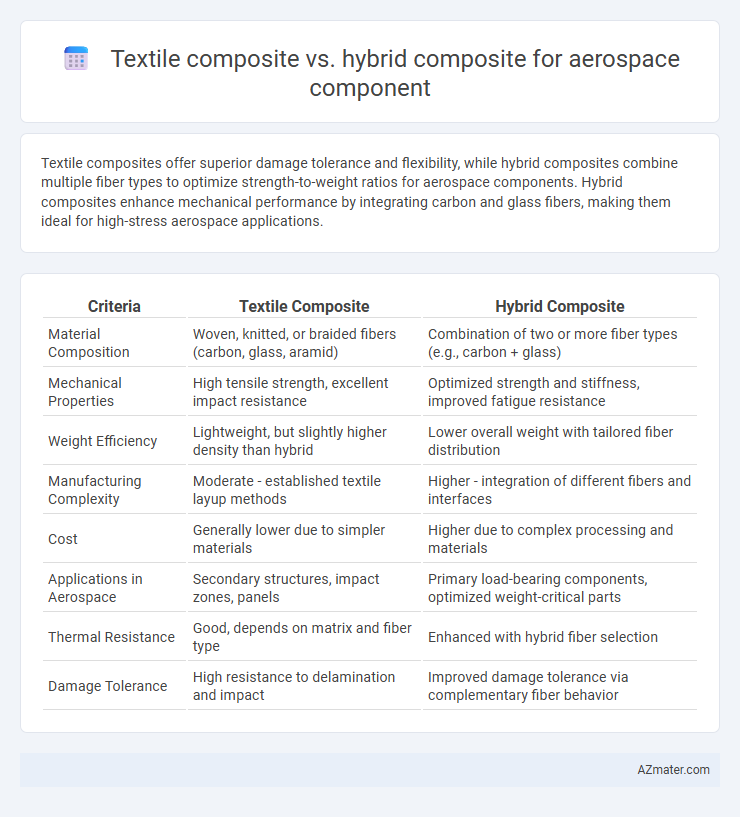Textile composites offer superior damage tolerance and flexibility, while hybrid composites combine multiple fiber types to optimize strength-to-weight ratios for aerospace components. Hybrid composites enhance mechanical performance by integrating carbon and glass fibers, making them ideal for high-stress aerospace applications.
Table of Comparison
| Criteria | Textile Composite | Hybrid Composite |
|---|---|---|
| Material Composition | Woven, knitted, or braided fibers (carbon, glass, aramid) | Combination of two or more fiber types (e.g., carbon + glass) |
| Mechanical Properties | High tensile strength, excellent impact resistance | Optimized strength and stiffness, improved fatigue resistance |
| Weight Efficiency | Lightweight, but slightly higher density than hybrid | Lower overall weight with tailored fiber distribution |
| Manufacturing Complexity | Moderate - established textile layup methods | Higher - integration of different fibers and interfaces |
| Cost | Generally lower due to simpler materials | Higher due to complex processing and materials |
| Applications in Aerospace | Secondary structures, impact zones, panels | Primary load-bearing components, optimized weight-critical parts |
| Thermal Resistance | Good, depends on matrix and fiber type | Enhanced with hybrid fiber selection |
| Damage Tolerance | High resistance to delamination and impact | Improved damage tolerance via complementary fiber behavior |
Introduction to Composite Materials in Aerospace
Textile composites in aerospace utilize woven fibers such as carbon, glass, or aramid to provide enhanced damage tolerance and impact resistance, ideal for load-bearing components. Hybrid composites combine different fiber types, like carbon and glass, to optimize mechanical properties, weight reduction, and cost efficiency simultaneously. Both materials play critical roles in advancing aerospace component performance by balancing strength, stiffness, and weight requirements.
Overview of Textile Composites
Textile composites in aerospace applications consist of interlaced fibers such as carbon, glass, or aramid, providing enhanced damage tolerance and impact resistance compared to traditional unidirectional composites. Their three-dimensional fiber architecture offers improved delamination resistance and structural integrity, ideal for complex aerospace components requiring high strength-to-weight ratios. The ability to tailor fiber orientation and weave patterns allows for optimized mechanical properties, making textile composites a versatile choice for aerospace structural parts.
Introduction to Hybrid Composites
Hybrid composites combine two or more types of reinforcing fibers, such as carbon, glass, or aramid, within a polymer matrix to enhance specific mechanical properties crucial for aerospace components. These materials offer tailored strength, stiffness, fatigue resistance, and impact tolerance, outperforming traditional textile composites that often rely on a single fiber type. The strategic hybridization in aerospace applications results in lightweight structures with optimized performance, meeting stringent industry standards for durability and efficiency.
Key Material Properties: Strength, Stiffness, and Fatigue
Textile composites exhibit superior impact resistance and damage tolerance due to their woven architecture, providing enhanced fatigue life and energy absorption in aerospace components. Hybrid composites combine distinct fiber types such as carbon and glass to optimize strength and stiffness, achieving higher specific modulus and tailored mechanical performance. The synergistic effect in hybrid composites often results in improved stiffness-to-weight ratio while maintaining adequate fatigue resistance, crucial for aerospace structural applications.
Weight Considerations in Aerospace Applications
Textile composites offer significant weight savings in aerospace components due to their superior fiber volume fraction and tailored fiber orientation, enhancing strength-to-weight ratios. Hybrid composites combine different fiber materials, such as carbon and glass, optimizing weight while improving impact resistance and fatigue performance. Weight considerations favor textile composites for lightweight structural parts, whereas hybrid composites provide balanced weight efficiency with enhanced durability in complex aerospace applications.
Manufacturing Processes and Scalability
Textile composites in aerospace manufacturing leverage weaving or braiding processes to create high-strength fiber architectures, offering excellent scalability through automated textile production methods. Hybrid composites combine different fiber types, such as carbon and glass, requiring more complex lay-up and curing techniques that can limit scalability due to increased process variability and assembly precision demands. Manufacturing hybrid composites involves careful control of material interfaces and resin systems, impacting cycle times and cost-effectiveness compared to the more streamlined, repeatable processes of textile composites.
Damage Tolerance and Impact Resistance
Textile composites, characterized by interlaced fiber architectures, exhibit superior damage tolerance due to enhanced crack deflection and energy dissipation compared to hybrid composites, which combine different fiber types but may have weaker fiber-matrix interfaces. Impact resistance in textile composites is significantly higher, benefiting from their woven structures that distribute impact forces more evenly across the material. Hybrid composites, while tailored for specific mechanical properties like stiffness or weight reduction, often face challenges in maintaining consistent damage tolerance under dynamic loading conditions in aerospace components.
Cost Efficiency and Lifecycle Analysis
Textile composites offer cost efficiency through automated manufacturing and reduced material waste, making them suitable for high-volume aerospace components. Hybrid composites combine multiple fiber types to optimize strength-to-weight ratios, potentially increasing upfront costs but enhancing lifecycle performance by improving fatigue resistance and damage tolerance. Lifecycle analysis often favors hybrid composites for critical aerospace parts due to their extended durability and lower maintenance requirements over time.
Comparative Performance in Aerospace Components
Textile composites exhibit superior flexibility and damage tolerance in aerospace components, enabling better impact resistance and fatigue performance compared to hybrid composites. Hybrid composites combine different fiber types, such as carbon and glass, to optimize stiffness and weight, but often sacrifice some durability under cyclic loading conditions. The choice between textile and hybrid composites depends on specific aerospace performance requirements, balancing structural integrity, weight savings, and manufacturing complexity.
Future Trends: Textile vs Hybrid Composites in Aerospace
Future trends in aerospace composites highlight increasing adoption of hybrid composites combining carbon, glass, and aramid fibers to enhance strength-to-weight ratios, fatigue resistance, and damage tolerance over traditional textile composites. Advances in automated manufacturing techniques and resin infusion processes are driving the scalability and cost-efficiency of hybrid composites in complex aerospace components. Ongoing research focuses on optimizing fiber architecture and matrix formulations in hybrid composites to meet stringent performance, thermal management, and sustainability requirements of next-generation aircraft.

Infographic: Textile composite vs Hybrid composite for Aerospace component
 azmater.com
azmater.com